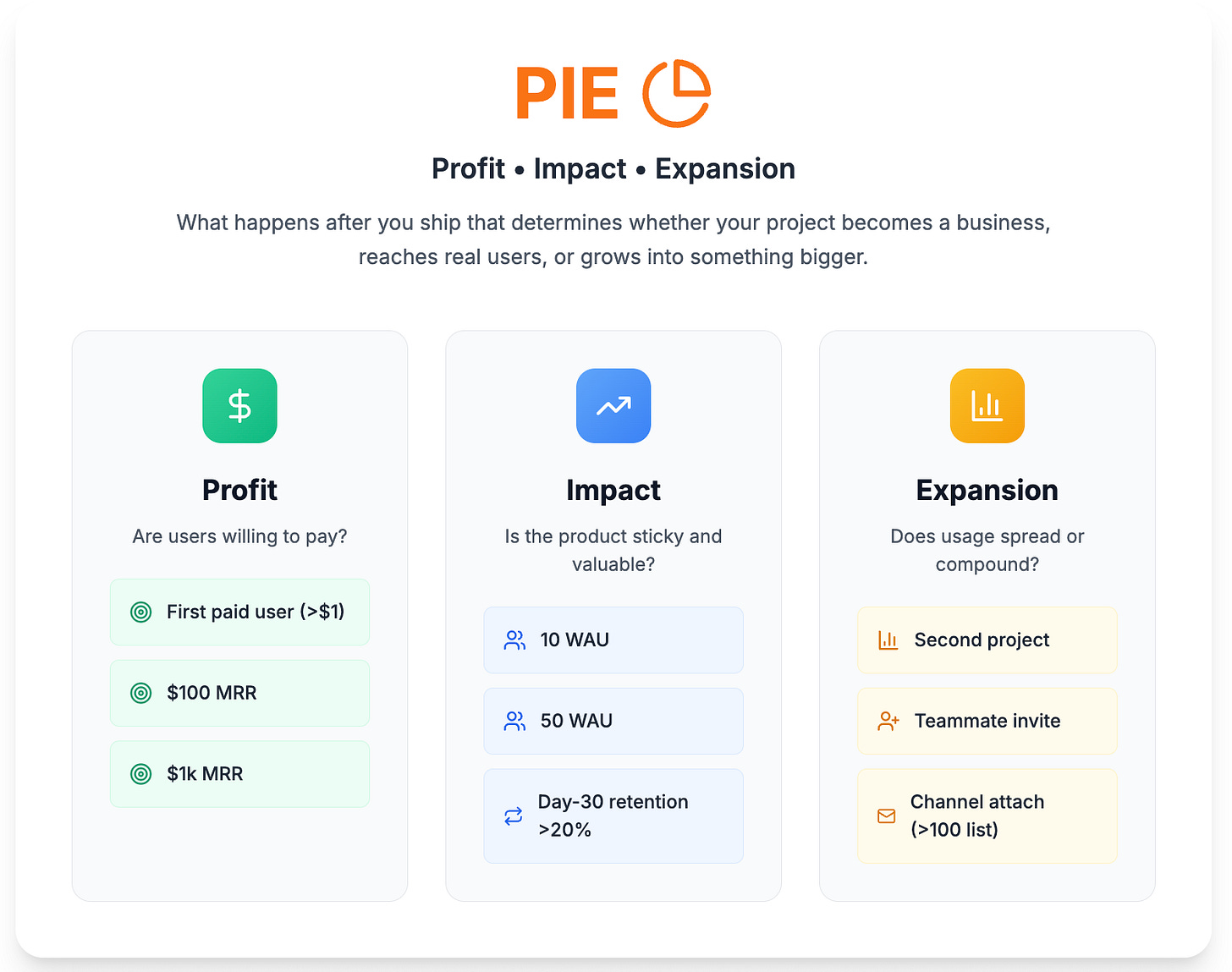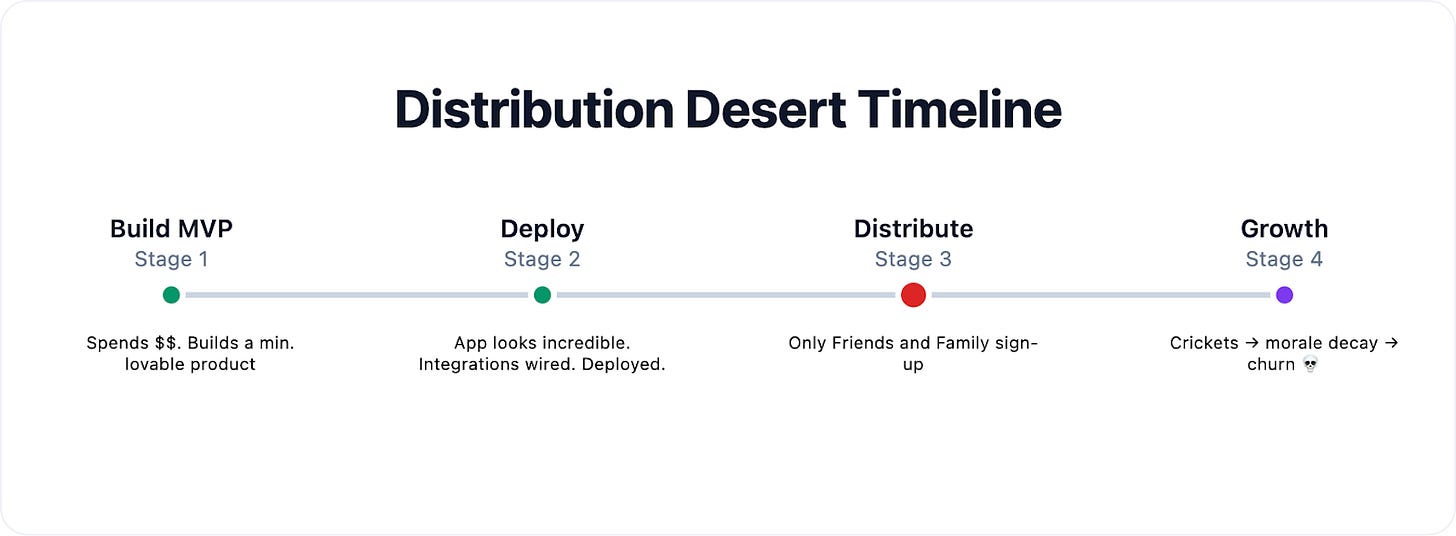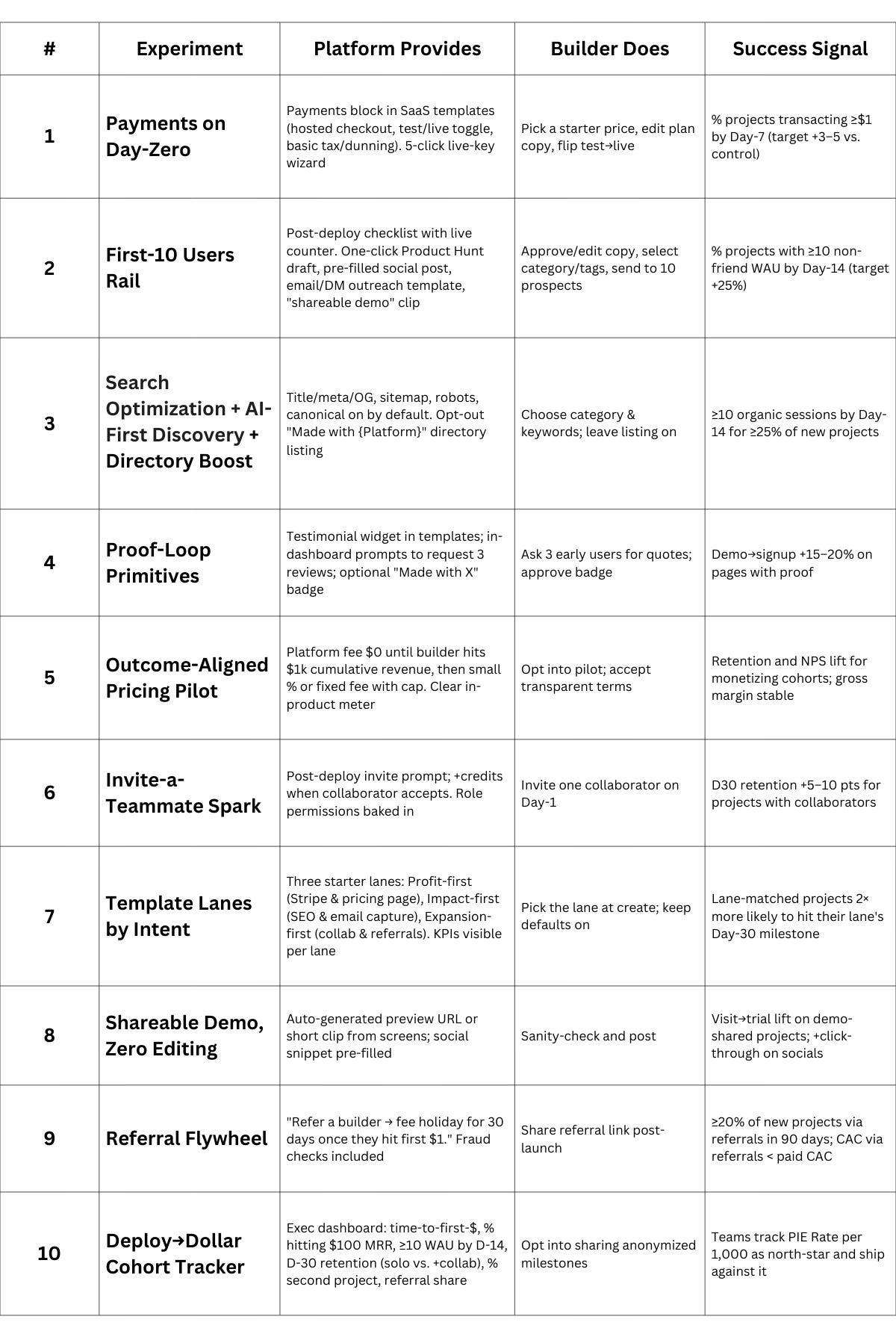Vibe coding alone won't get you to your first $1k
Most apps never make it past launch. Here’s how builders unlock real users, real revenue, and real traction with AI.
👋 Hi, it’s Gaurav and Kunal, and welcome to the Insider Growth Group newsletter—our bi-weekly deep dive into the hidden playbooks behind tech’s fastest-growing companies.
We give you an edge on what’s happening today: actionable strategies, proven frameworks, and access to how top operators are scaling companies across industries. This newsletter helps you boost your key metrics—whether you're launching a product from scratch or scaling an existing one.
What We Stand For
Actionable Insights: Our content is a no-fluff, practical blueprint you can implement today, featuring real-world examples of what works—and what doesn’t.
Vetted Expertise: We rely on insights from seasoned professionals who truly understand what it takes to scale a business.
Community Learning: Join our network of builders, sharers, and doers to exchange experiences, compare growth tactics, and level up together.
Introduction
Anyone can ship an app in 48 hours with AI coding tools. In 48 days, fewer than 2–5%* reach $100 in revenue. The real failure point is after launch: most projects never get a single paying customer or sustained usage. The winners won’t optimize time-to-demo, they’ll optimize time-to-first customer, time-to-returning users, and time-to-repeatable growth. This piece shows where today’s tools help (and don’t) and what defaults platforms should ship next to close that gap.
The Missing Half
AI coding platforms have solved half the problem i.e., democratizing software creation. Cursor ($9.9B valuation), Lovable (unicorn in 8 months), and Replit ($3B valuation) collapse idea → code → deploy to hours. That’s the Prompt → Product win: usable code, live URLs, a real app you can click.
But to truly deliver on their promise, the platform that solves value capture will own this market. Code generation speed is table stakes; helping users make their first dollar is the unbreachable moat.
We call this missing piece PIE, the post-ship outcomes that turn demos into businesses. The framework comes from the idea that if we're enabling everyone to build, then everyone should get a piece of the PIE, not just the ability to bake it.
Introducing Aparna
Aparna Somaiah is a fractional PM who partners with early-stage teams on product strategy and growth. Previously at Airbnb (mobile developer experience) and VMware (enterprise cloud infrastructure), she uses AI coding tools to rapidly prototype and ship solutions. You can connect with her on LinkedIn.
Now, what is PIE?
PIE = Profit, Impact, Expansion. This is the outcome after you ship that determines whether your project becomes a business, reaches real users, or grows into something bigger. PIE is not a replacement for AARRR; it’s a platform-side lens for what must be defaulted so builders can cross the deploy → first user → first dollar barrier.
PIE is your early scoreboard for whether projects are on a path to sustainable growth. Instead of fuzzy concepts like “traction,” it defines three dimensions with clear, testable milestones:
Profit – Are users willing to pay?
First paid user (>$1)
$100 MRR
$1k MRR
Impact – Is the product sticky and valuable?
10 WAU
50 WAU
Day-30 retention > 20% on a core action
Expansion – Does usage spread or compound?
Second project in the same account
Teammate invite
Channel attach (e.g.,>100 email list, referral loop enabled)
To unify these into one metric, track the PIE Rate:
PIE Rate per 1,000 projects = % that hit any milestone above within 60 days.
Think of this as the “DAU/WAU” equivalent for platforms. It gives your team a single, measurable scoreboard for whether projects are breaking through to real adoption and monetization.
It represents the core promise of democratizing software creation: if everyone can build, everyone should get a piece of the economic and social value that software creates. Today, most platforms drop users right after deployment without helping them achieve any of these outcomes.
The Distribution Desert
Every platform uses the same psychology trick: the cost-ladder. You start free, burn through credits fast, and hit limits right when you're excited about your project. You then upgrade to keep momentum. Across the category, the loop is the same: Lovable gives 5 free daily credits, then paid monthly credit buckets; Replit bundles $25 monthly credits and meters Agent/hosting; Cursor includes $20 of agent usage on Pro: each creates friction exactly when you want to iterate, and paying creates commitment.
This skin-in-the-game approach works brilliantly for getting users to finish and deploy their projects. But here's the problem: most platforms capture this commitment without bridging to PIE outcomes. This is where users hit the Distribution Desert.
Stage 1: Invest ~$100 + ~48 hrs to build a gorgeous app
Stage 2: Looks incredible. Deployed and integrations wired
Stage 3: No users beyond friends and family
Stage 4–8: Lack of traction → morale decay → churn
Platforms capture commitment, then abandon users at the hardest step: finding and converting the first 10 real users. That’s the Product → PIE gap.
Users stuck in the desert often build multiple projects hoping one will break through, but without PIE infrastructure, each new project hits the same distribution wall. Instead of one successful app, they end up with a graveyard of deployed demos.
Users who can't reach PIE churn within 3-6 months, regardless of their initial investment. The commitment ladder breaks when business outcomes don't materialize.
The distribution desert is not new; most apps die here. What’s new is that these platforms market the full journey to “ship a product”. If the journey stops at deploy, the promise is only half fulfilled.
Take Lovable's growth motion: it's a masterclass in growth hacking with high-signal leadership, back-to-back hackathons, free-token bursts, and relentless social proof. It's exactly what you run in a nine-month-old land-grab: compete on acquisition velocity and headline ARR. But with LLM costs still squeezing margins and most cohorts <12 months old, the real operating heartbeat is MRR and retention, not splashy ARR. The distribution desert is where those surges either convert or decay. (This is true across the category; Lovable just shows the acquisition playbook at its best.)
This isn't an argument that those tactics "won't work"; they work brilliantly for attention. The question is whether that attention should be routed into default business rails - the basic operating system every serious product needs to survive. Hence, acquisition spikes cross deploy → first user → first dollar: payments wired by default, SEO + analytics on, proof/trust loops, and a guided "first-10 users" checklist. Without these rails, you get short-cycle MRR and churn; with them, builders escape the desert and hit PIE.
If platforms shoulder the operating rails that move builders from deploy → first user → first dollar, pricing should shift to reflect outcomes, not just usage.
If you’ve gotten this far, you may be ready to navigate to the 🔥 section and check out our Playbook now.
The Partnership Patterns
The partnership patterns via integrations (Replit, Lovable, Windsurf), hackathon bundles (Bolt.new hackathon, Lovable Shipped, TPF Mosaic), and newsletter perks reveal exactly where platforms may be evaluating opportunity. Every platform has partnered with identical services:
Deployments: Supabase across all platforms
Payments: Stripe is also available across all platforms
Authentication: Scalekit, Clerk, and Auth0 in every integration list
Hosting: Vercel, Netlify, AWS, GCP, CloudFlare everywhere
Marketing and Sales: Hubspot, Apollo.io, Google Ads, MailChimp
Collaboration: Linear, Superhuman, Granola
And more…
When every platform partners with Stripe, that's not a coincidence. It's acknowledgment that payment integration, a core Profit component, remains too complex for AI to generate reliably. These partnerships map directly to PIE gaps, revealing exactly where Prompt → Product breaks down and specialized infrastructure is needed.
Default rails ≠ default blast. The goal isn't to flood the internet with new applications; it's to default the plumbing (payments, SEO, analytics, proof) so serious builders can validate faster.
Evidence the PIE Gap Exists: AI Coding Assistants Reality Check
Here's how the five major AI coding assistants and AI coding IDEs stack up on enabling PIE today.
Legend: 🟩 = Defaulted & guided · 🟨 = Available/turnkey · ⬜ = 0 Absent/DIY. Colors reflect defaulted, guided paths to first users/first dollar, not mere availability.
Indicative snapshot based on public signals and hands-on use; this changes fast. Achieving PIE is about moving to Green. This looks binary, but it isn’t. Green ≠ “better product,” it means the platform makes that step default. Yellow means the capability exists with a guided hand-off (often perfectly fine for technical users). Gray often reflects product philosophy (e.g., IDE-first tools like Cursor intentionally avoid bundling business rails). Note: execution quality varies - Replit excels at hosting, Bolt/Cursor at deployment. This scorecard measures enablement, not excellence.
Here's what's happening at each platform:
Replit: One-click deploy + easy first-party hosting with transparent pricing; basic analytics. Missing: automatic payments, SEO defaults, and trust/proof loops.
Lovable: Top-of-funnel masterclass; guided integrations and domains. Missing: first-party hosting, default analytics + milestone tracking; stronger design-to-code handoff.
Bolt: End-to-end rails in browser (beta): integrated deploy/hosting, Stripe-ready starters, built-in analytics. Missing: consistent SEO defaults; mature trust loops.
Cursor: IDE-first; elite iteration & MCP integrations; deploy/hosting via hand-offs. Missing: bundled business rails (domains, payments, SEO, analytics, proof).
Windsurf: Agent-forward editor; strong Prompt→Product, thin Product→PIE. Missing: bundled domains/hosting/payments/analytics/SEO/proof.
The Coming Shift: Outcome-Based Pricing
As platforms start defaulting the rails that create outcomes: hosting, domains, payments, SEO, analytics, proof loops, pricing should evolve to match. There will be a rise in outcome based pricing models as a result: $0 platform fee until the project earns, then a small, capped share or a fixed operating fee after a clear threshold (e.g., first $1,000 cumulative revenue). This aligns incentives (the platform wins when builders win), improves margin health, and, crucially, rewards the work of turning Prompt → Product into PIE (Profit, Impact, Expansion).
This is consistent with adjacent ecosystems where builders accept revenue-aligned fees (e.g., commerce/payment platforms that combine a subscription with a small per-transaction take). For solo creators and small teams who'd otherwise spend tens of thousands with an agency to reach the same "operating product" (deploy, payments, analytics, SEO, basic GTM), the swap is compelling: predictable build-time subscription + light success fee once revenue begins = meaningful savings and a clearer path to sustain.
For example
$0 platform fee until $1,000 cumulative revenue
Then 2–5% take rate with a monthly cap (e.g., fee caps at $99/mo) or a flat $29–$49/mo operating plan once past the threshold
Keep the existing subscription for build features; reserve the success fee for the operating layer (payments/billing/taxes, analytics, SEO, proof loops, compliance)
🔥 Insider Growth Playbook: 10 Vibe Coding Builder Experiments to Cross the Product → PIE Bridge
Shipping an app with tools like Cursor, Replit, Lovable, or Windsurf is easy. The hard part is what comes after: finding real users, earning your first dollar, and proving your idea can grow.
The playbook below is designed for you, the builder. These aren’t just feature ideas for platforms they’re joint experiments you can run right now using what the vibe coding platforms already give you.
The rule of thumb: the platform handles the wiring (payments, SEO, analytics, proof loops), and you supply the small but critical inputs (copy, tags, prices). Run these as lightweight tests, and you’ll dramatically improve your odds of crossing the bridge from demo → first user → first dollar.
Who's it for:
Platform = AI coding tools (Cursor, Replit, Lovable, Windsurf, Bolt) that provide the infrastructure and defaults
Builder = Anyone using these AI coding tools to create applications - from solo founders to PMs at companies validating new ideas
How to read this:
Platform provides = what the tool should default/generate for you.
Builder does = the small inputs creators add (copy, tags, prices).
Success signal = the single number that means it worked.
Defaults beat intentions. If payments, SEO, proof, and invites are on by default, builders cross deploy → first user → first dollar with less friction.
Tiny inputs, big unlocks. Builders supply copy, prices, and tags; the platform handles wiring, compliance, and measurement.
One scoreboard. If PIE Rate per 1,000 projects rises, the bridge from Product → PIE is getting real.
Why This Matters Now
Assume 2-5% of deployed projects ever reach $100+ monthly revenue. This represents a massive opportunity: platforms that can systematically improve Profit, Impact, and Expansion rates will dominate the market. The timeline is urgent. Over the next 12–18 months, Big Tech bundling will make Prompt→Product a commodity; PIE becomes the defensible surface.
The metric that matters isn't total deployments or daily active users. It's PIE stories per 1,000 users: how many users achieve meaningful Profit, Impact, or Expansion outcomes. This is the measure that will separate the platforms that create businesses from those that just make demos.
The Bottom Line
Prompt → Product is solved. Anyone can now build and deploy apps quickly.
The winners will be platforms that solve Product → PIE. They'll help users find customers, generate revenue, reach real users, and scale successfully.
Stop optimizing "time to demo."
Start optimizing "time to PIE."
The platforms that systematically enable users to get their piece of the pie, not just bake it, will own this market.
Want help turning your vibe coding demos into a revenue generating products?
Let’s talk.









